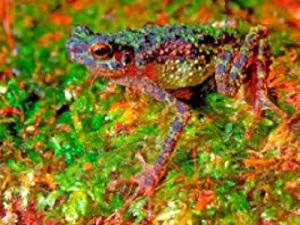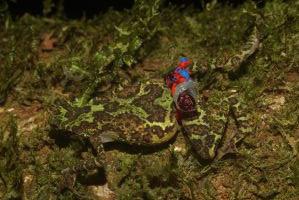Jia Jet Ong
This study aims to advance the understanding of biology and ecology of the Bornean Rainbow Toad, Ansonia latidisca along Gunung Penrissen, western Sarawak.

Ansonia latidisca
The only published literature of Ansonia latidisca is the original description of Robert Inger in 1966, which referred it as a montane species. He described three individuals of A. latidisca from two locations in the north-western corner of Borneo: one from Mount Damus, Samba, Kalimantan and two from Gunung Penrissen, Sarawak.

Female Ansonia latidisca attached with a bobbin thread.
Since late 1920s, this species has not been recorded. However, in a recent project initiated by The Search for Lost Frogs’ campaign, three individuals of A. latidisca were again discovered. Thus, this project serves as a continuation of the existing project, aims to review the density and distribution of A. latidisca and to advance its quantitative ecological aspects in the Gunung Penrissen. Basic ecological questions which are still unknown such as a) what is the microhabitat of A. latidisca b) what are their reproduction mode and strategy? And c) what is the call of A. latidisca? Etc. will hope to be answered.
Field surveys are generally planned during the early morning for tadpole’s collection and late evening for investigating its diel activity cycle. When an A. latidisca is discovered and identified, we will approach it slowly and grab it by hand. Basic biological data will be taken for each individual, for example: measurements (including standard lengths and snout-vent lengths); sex (male, female or juvenile); and dietary contents (by stomach flushing methods. We will also mark the place we find the bufonid with a reflecting tape. During the study period, we plan to revisit the place and attempt to locate the bufonid from where the origin place it is found by observing it from >5 m away. Environmental features (including maximum and minimum elevation, forest type, degree of anthropogenic disturbance, presence or absence of nearby water bodies for answering doubts on reproduction modes, etc) will be recorded on weatherproof papers for its habitat and microhabitat data.
We hope that the database developed will be a permanent asset for use by future researchers interested on A. latidisca and external agencies.